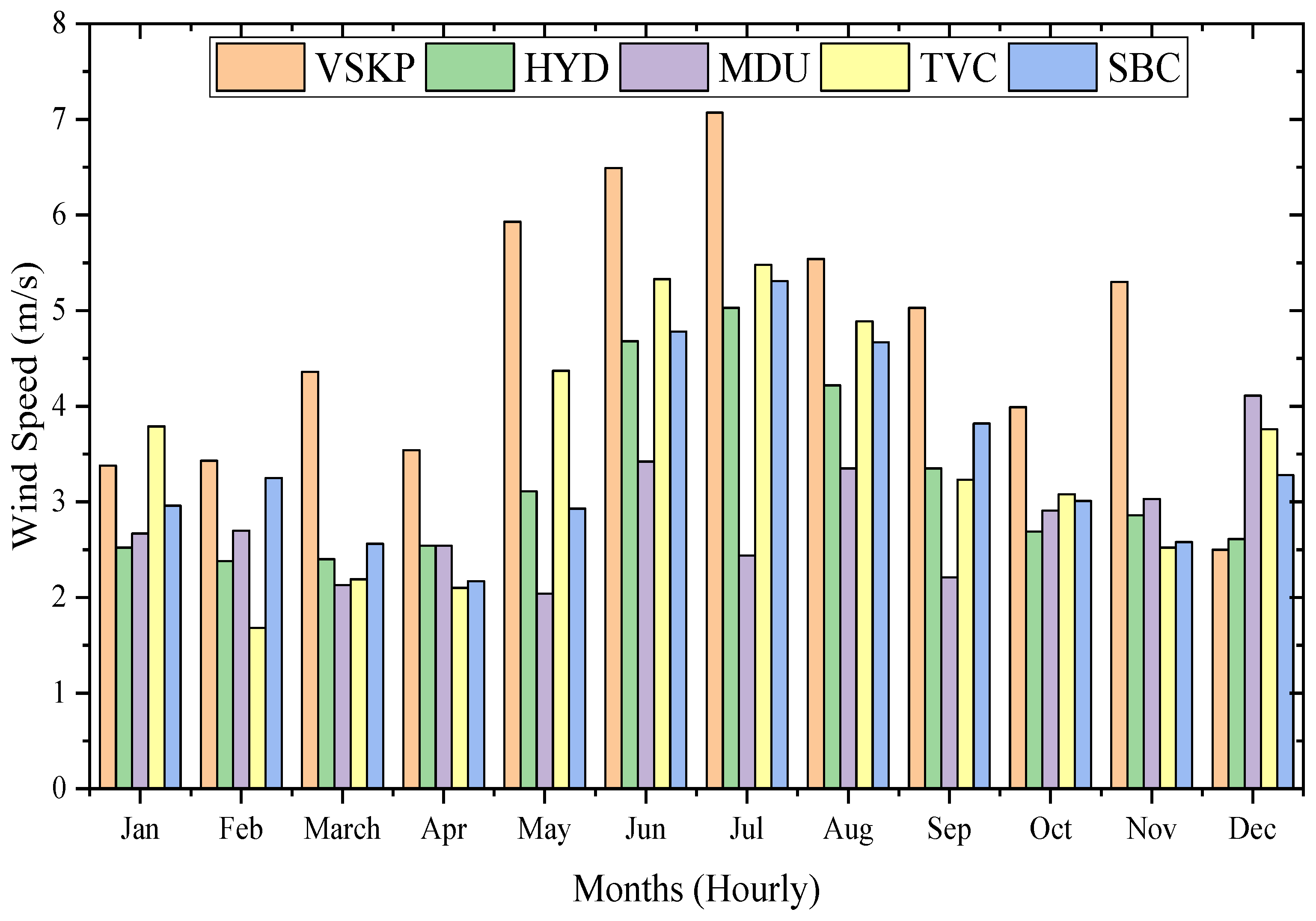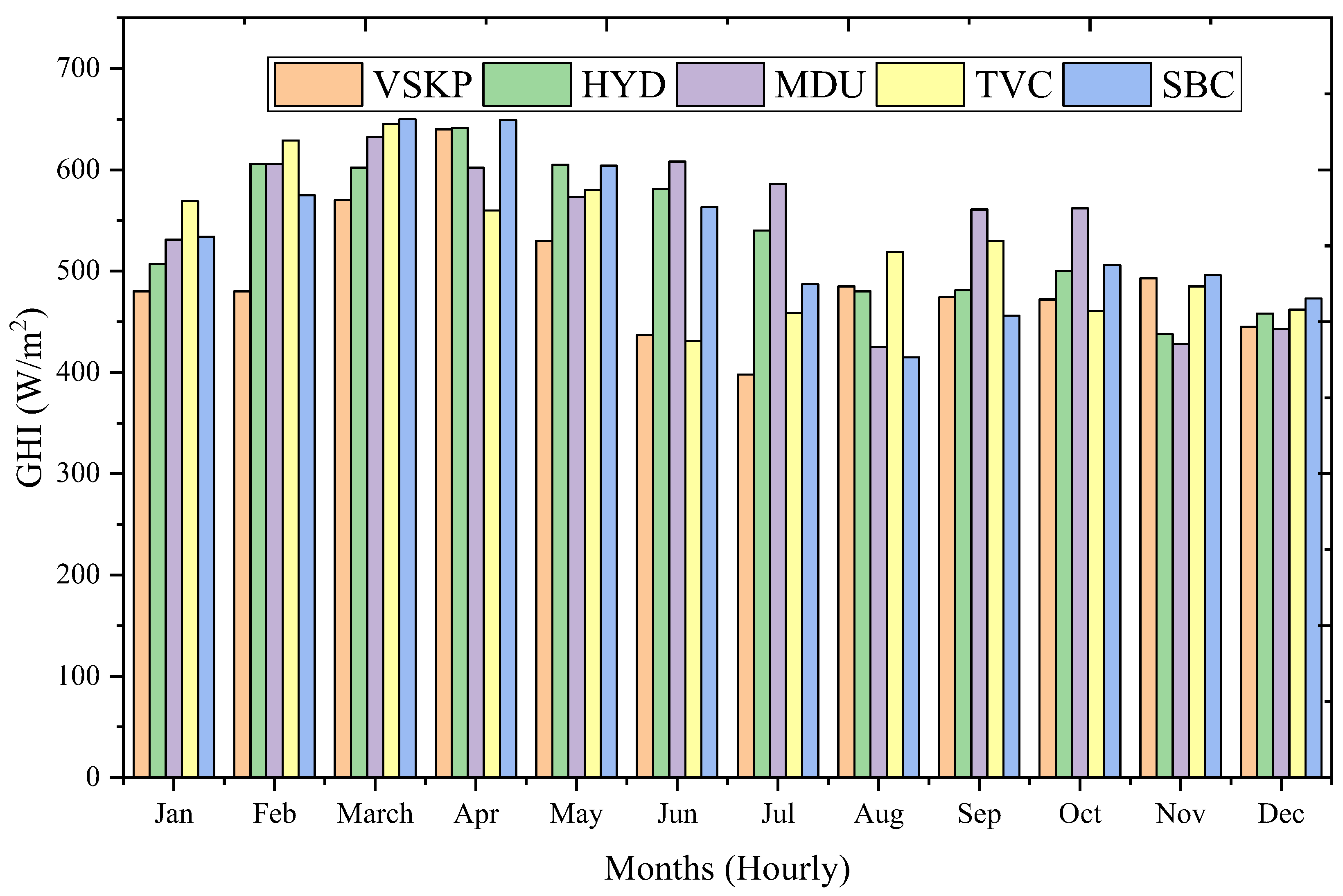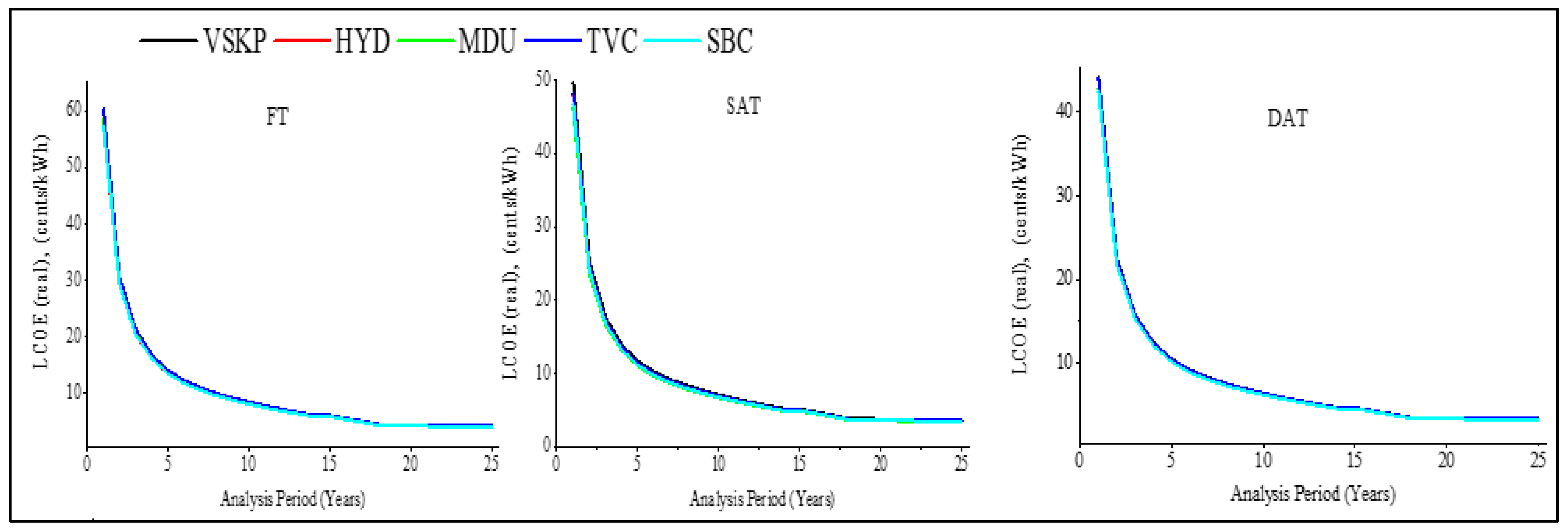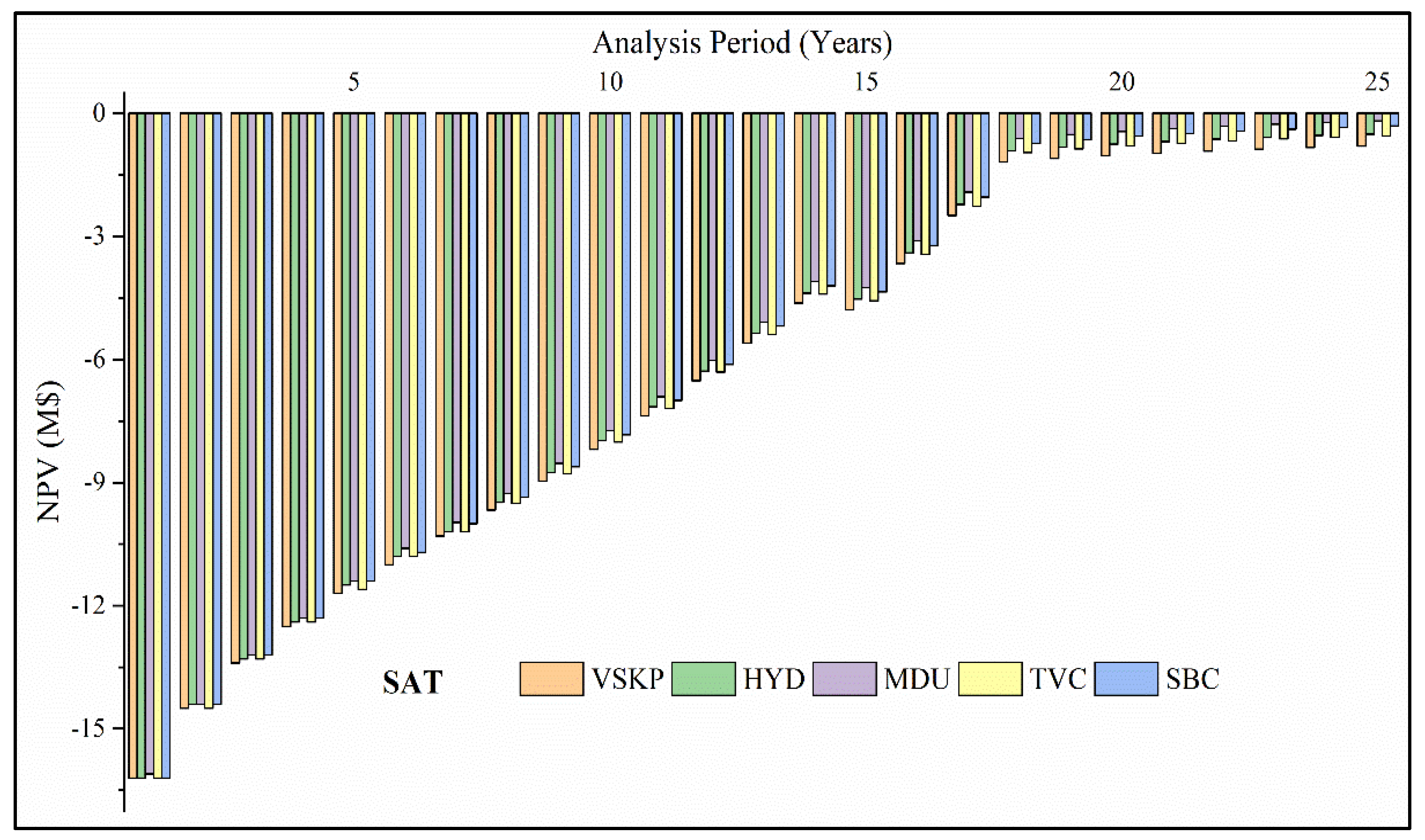Comparative Analysis for a Solar Tracking Mechanism of Solar PV in Five Different Climatic Locations in South Indian States: A Techno-Economic Feasibility
Abstract
:1. Introduction
1.1. India’s Solar Energy Potential and Solar Radiation
1.2. Mechanism of Solar Tracking System
1.3. Geographical Features and Solar Resource of the Present Study
| Region | Location | Lat (°N) | Long (°E) | DNI (kWh/m2/Day) | GHI (kWh/m2/Day) |
|---|---|---|---|---|---|
| Andhra Pradesh | VSKP | 17.68 | 83.21 | 4.6 | 5.4 |
| Telangana | HYD | 17.38 | 78.48 | 4.8 | 5.7 |
| Tamil Nadu | MDU | 9.92 | 78.11 | 5.0 | 5.9 |
| Kerala | TVC | 8.48 | 76.95 | 4.5 | 5.5 |
| Karnataka | SBC | 12.97 | 77.54 | 5.5 | 5.8 |

2. Materials and Methods
2.1. Financial Factors
- ✓
- The charges for local and state taxes;
- ✓
- Operational costs, such as insurance premiums, maintenance and repair (O&M), and real estate taxes;
- ✓
- Capital for disbursal of assets or reserves, such as working capital, debt servicing, and equipment replacement;
- ✓
- The project’s equity investment covers sales tax, project development fees, labour and equipment expenditures, and finance fees.
2.2. Performance of Weather Characteristics Obtained from the Study
3. Results
3.1. Technical Results for PV System for Three Mechanisms
3.2. Economic Analysis for PV System for Three Mechanisms
3.3. Sensitivity Analysis for PV System for Three Mechanisms
3.4. Comparison with Other Studies
3.5. Compartive Analysis of the Present Study
4. Conclusions, limitations and Policy Recommendations from the Study
4.1. Limitations of the Current Study
4.2. Policy Implications Development of RE Sources in South India
- To install a proper RE source in India, proper strategies, planning, and re-framing of the current energy policies.
- Imports from the international markets should be decreased, and in the meantime, encourage the local manufacturing units to adopt fast manufacturing to save time and be cost-effective.
- To encourage the local communities to install solar RE sources in the residential complex area by providing loans and an exemption from the tax.
- Training programs from the experts should be initiated for the local communities. They should be implemented for installing, operating, and maintaining, solar RE sources.
- The lack of financial constraints due to the increase in the poverty line in India causes an effect on the budget allocation of solar RE sources.
- The ministry of energy and power resources should continuously engage with experts in solar RE sources from various educational institutes and firms to find potential areas to install PV power plants.
Author Contributions
Funding
Institutional Review Board Statement
Informed Consent Statement
Data Availability Statement
Acknowledgments
Conflicts of Interest
Appendix A
| Description | Characteristics | Value |
| System Design [20] | Modules pers string in subarray | 12 |
| Strings in parallel subarray | 53,744 | |
| Modules in subarray | 64,488 | |
| Strings in Voc at reference condition | 772.8 V | |
| Strings in Vmp at reference condition | 656.4 V | |
| Inverter [20] | Model: Yaskawa Soleectria Solar: SGI 750 XTMM | - |
| Total number of inverters | 22 | |
| DC-to-AC ratio | 1.21 | |
| Name plate DC capacity | 20 MWdc | |
| Total inverter capacity | 17 MWdc | |
| Maximum DC power | 0.78 MWdc | |
| Power used during operation | 3.71 kWdc | |
| Maximum DC voltage | 820 Vdc | |
| Maximum AC current | 1263.77 Adc | |
| Minimum MPPT DC voltage | 545 Vdc | |
| Maximum MPPT DC voltage | 820 Vdc | |
| Manufacturer | SunPower SPR-E19-310-COM | |
| Physical Characteristics | Material: Mono-c-Si | |
| Module length | 1.631 m | |
| Module width | 1 m | |
| Total irradiance | 1000 W/m2 | |
| Cell temperature | 25 °C | |
| Maximum power | 310.149 Wdc | |
| Maximum power voltage | 54.7 Vdc | |
| Maximum power current | 5.7 Adc | |
| Open circuit voltage | 64.4 Vdc | |
| Short circuit current | 6.0 Adc | |
| Lifetime and Degradation [15,56,57] | Annual DC degradation rate | 0.5%/year |


References
- Praveenkumar, S.; Gulakhmadov, A.; Agyekum, E.B.; Alwan, N.T.; Velkin, V.I.; Sharipov, P.; Safaraliev, M.; Chen, X. Experimental Study on Performance Enhancement of a Photovoltaic Module Incorporated with CPU Heat Pipe—A 5E Analysis. Sensors 2022, 22, 6367. [Google Scholar] [CrossRef] [PubMed]
- PraveenKumar, S.; Agyekum, E.B.; Velkin, V.I.; Yaqoob, S.J.; Adebayo, T.S. Thermal management of solar photovoltaic module to enhance output performance: An experimental passive cooling approach using discontinuous aluminum heat sink. Int. J. Renew. Energy Res. IJRER 2021, 11, 1700–1712. [Google Scholar]
- Andal, A.G.; PraveenKumar, S.; Andal, E.G.; Qasim, M.A.; Velkin, V.I. Perspectives on the Barriers to Nuclear Power Generation in the Philippines: Prospects for Directions in Energy Research in the Global South. Inventions 2022, 7, 53. [Google Scholar] [CrossRef]
- Agyekum, E.B.; PraveenKumar, S.; Alwan, N.T.; Velkin, V.I.; Shcheklein, S.E. Effect of dual surface cooling of solar photovoltaic panel on the efficiency of the module: Experimental investigation. Heliyon 2021, 7, e07920. [Google Scholar] [CrossRef]
- Agyekum, E.B.; PraveenKumar, S.; Alwan, N.T.; Velkin, V.I.; Shcheklein, S.E.; Yaqoob, S.J. Experimental Investigation of the Effect of a Combination of Active and Passive Cooling Mechanism on the Thermal Characteristics and Efficiency of Solar PV Module. Inventions 2021, 6, 63. [Google Scholar] [CrossRef]
- Agyekum, E.B.; PraveenKumar, S.; Eliseev, A.; Velkin, V.I. Design and Construction of a Novel Simple and Low-Cost Test Bench Point-Absorber Wave Energy Converter Emulator System. Inventions 2021, 6, 20. [Google Scholar] [CrossRef]
- Agyekum, E.B.; PraveenKumar, S.; Alwan, N.T.; Velkin, V.I.; Adebayo, T.S. Experimental Study on Performance Enhancement of a Photovoltaic Module Using a Combination of Phase Change Material and Aluminum Fins—Exergy, Energy and Economic (3E) Analysis. Inventions 2021, 6, 69. [Google Scholar] [CrossRef]
- Postoglu, D.; Öner, İ.V. A Comparison Between Fixed Solar Panel and Dual-Axis Solar Tracking System in Menderes District. Int. J. Innov. Res. Rev. 2021, 5, 32–38. [Google Scholar]
- Kumar, A.; Kumar, K.; Kaushik, N.; Sharma, S.; Mishra, S. Renewable energy in India: Current status and future potentials. Renew. Sustain. Energy Rev. 2010, 14, 2434–2442. [Google Scholar] [CrossRef]
- Kymakis, E.; Kalykakis, S.; Papazoglou, T.M. Performance analysis of a grid connected photovoltaic park on the island of Crete. Energy Convers. Manag. 2009, 50, 433–438. [Google Scholar] [CrossRef]
- Sundaram, S.; Babu, J.S.C. Performance evaluation and validation of 5MWp grid connected solar photovoltaic plant in South India. Energy Convers. Manag. 2015, 100, 429–439. [Google Scholar] [CrossRef]
- D’Adamo, I.; Falcone, P.M.; Gastaldi, M.; Morone, P. The economic viability of photovoltaic systems in public buildings: Evidence from Italy. Energy 2020, 207, 118316. [Google Scholar] [CrossRef]
- Bouacha, S.; Malek, A.; Benkraouda, O.; Arab, A.H.; Razagui, A.; Boulahchiche, S.; Semaoui, S. Performance analysis of the first photovoltaic grid-connected system in Algeria. Energy Sustain. Dev. 2020, 57, 1–11. [Google Scholar] [CrossRef]
- Aziz, A.S.; Tajuddin, M.F.N.; Adzman, M.R.; Mohammed, M.F.; Ramli, M.A.M. Feasibility analysis of grid-connected and islanded operation of a solar PV microgrid system: A case study of Iraq. Energy 2020, 191, 116591. [Google Scholar] [CrossRef]
- Pillai, G.; Naser, H.A.Y. Techno-economic potential of largescale photovoltaics in Bahrain. Sustain. Energy Technol. Assess. 2018, 27, 40–45. [Google Scholar] [CrossRef]
- Zou, H.; Du, H.; Brown, M.A.; Mao, G. Large-scale PV power generation in China: A grid parity and techno-economic analysis. Energy 2017, 134, 256–268. [Google Scholar] [CrossRef]
- Kazem, H.A.; Albadi, M.H.; Al-Waeli, A.H.A.; Al-Busaidi, A.H.; Chaichan, M.T. Techno-economic feasibility analysis of 1MW photovoltaic grid connected system in Oman. Case Stud. Therm. Eng. 2017, 10, 131–141. [Google Scholar] [CrossRef]
- Xu, L.; Wang, Y.; Solangi, Y.A.; Zameer, H.; Shah, S.A.A. Off-Grid Solar PV Power Generation System in Sindh, Pakistan: A Techno-Economic Feasibility Analysis. Processes 2019, 7, 308. [Google Scholar] [CrossRef]
- Alshare, A.; Tashtoush, B.; Altarazi, S.; El-khalil, H. Energy and economic analysis of a 5 MW photovoltaic system in northern Jordan. Case Stud. Therm. Eng. 2020, 21, 100722. [Google Scholar] [CrossRef]
- Agyekum, E.B. Techno-economic comparative analysis of solar photovoltaic power systems with and without storage systems in three different climatic regions, Ghana. Sustain. Energy Technol. Assess. 2020, 43, 100906. [Google Scholar] [CrossRef]
- Camilo, F.M.; Castro, R.; Almeida, M.E.; Pires, V.F. Economic assessment of residential PV systems with self-consumption and storage in Portugal. Sol. Energy 2017, 150, 353–362. [Google Scholar] [CrossRef]
- Adaramola, M.S. Techno-economic analysis of a 2.1kW rooftop photovoltaic-grid-tied system based on actual performance. Energy Convers. Manag. 2015, 101, 85–93. [Google Scholar] [CrossRef]
- Installed Capacity of Various Renewable Modes of Energy. Available online: https://pib.gov.in/Pressreleaseshare.aspx?PRID=1564039 (accessed on 22 August 2022).
- Renewable Energy Industry, Solar Energy Companies in India—IBEF. Available online: https://www.ibef.org/industry/renewable-energy (accessed on 22 August 2022).
- Hafez, A.Z.; Yousef, A.M.; Harag, N.M. Solar tracking systems: Technologies and trackers drive types—A review. Renew. Sustain. Energy Rev. 2018, 91, 754–782. [Google Scholar] [CrossRef]
- Qiu, L.; He, L.; Lu, H.; Liang, D. Systematic potential analysis on renewable energy centralized co-development at high altitude: A case study in Qinghai-Tibet plateau. Energy Convers. Manag. 2022, 267, 115879. [Google Scholar] [CrossRef]
- Abdelghani-Idrissi, M.A.; Khalfallaoui, S.; Seguin, D.; Vernières-Hassimi, L.; Leveneur, S. Solar tracker for enhancement of the thermal efficiency of solar water heating system. Renew. Energy 2018, 119, 79–94. [Google Scholar] [CrossRef]
- Gerra, D.D.; Iakovleva, E.V. Sun tracking system for photovoltaic batteries in climatic conditions of the Republic of Cuba. IOP Conf. Ser. Mater. Sci. Eng. 2019, 643, 012155. [Google Scholar] [CrossRef]
- Hoffmann, F.M.; Molz, R.F.; Kothe, J.V.; Nara, E.O.B.; Tedesco, L.P.C. Monthly profile analysis based on a two-axis solar tracker proposal for photovoltaic panels. Renew. Energy 2018, 115, 750–759. [Google Scholar] [CrossRef]
- Kumar, D. Mapping solar energy potential of southern India through geospatial technology. Geocarto Int. 2019, 34, 1477–1495. [Google Scholar] [CrossRef]
- Solar Resource Maps of India. Available online: https://solargis.com/maps-and-gis-data/download/india (accessed on 22 August 2022).
- Kamel, S.; Agyekum, E.B.; Adebayo, T.S.; Taha, I.B.M.; Gyamfi, B.A.; Yaqoob, S.J. Comparative Analysis of Rankine Cycle Linear Fresnel Reflector and Solar Tower Plant Technologies: Techno-Economic Analysis for Ethiopia. Sustainability 2022, 14, 1677. [Google Scholar] [CrossRef]
- Hernández-Moro, J.; Martínez-Duart, J.M. Analytical model for solar PV and CSP electricity costs: Present LCOE values and their future evolution. Renew. Sustain. Energy Rev. 2013, 20, 119–132. [Google Scholar] [CrossRef]
- Qasim, M.A.; Alwan, N.T.; PraveenKumar, S.; Velkin, V.I.; Agyekum, E.B. A New Maximum Power Point Tracking Technique for Thermoelectric Generator Modules. Inventions 2021, 6, 88. [Google Scholar] [CrossRef]
- OECD. Energy Technology Perspectives 2008: Scenarios and Strategies to 2050; Organisation for Economic Co-operation and Development: Paris, France, 2008. [Google Scholar]
- Income Tax Slab for FY 2022-23, FY 2021-22|Revised Income Tax Slabs, New & Old Tax Rates in India. Available online: https://cleartax.in/s/income-tax-slabs (accessed on 7 March 2022).
- Welcome to Commercial Taxes Department. Available online: https://apct.gov.in/apportal/AllActs/APVAT/APVATSchedules.aspx (accessed on 7 March 2022).
- National Institute of Public Finance and Policy. Sales Tax Systems In India: A Profile; National Institute of Public Finance and Policy: New Delhi, India, 1956; pp. 1–15. [Google Scholar]
- Jensen, A.R.; Sifnaios, I.; Furbo, S.; Dragsted, J. Self-shading of two-axis tracking solar collectors: Impact of field layout, latitude, and aperture shape. Sol. Energy 2022, 236, 215–224. [Google Scholar] [CrossRef]
- Morales Pedraza, J. Chapter 4—Current Status and Perspective in the Use of Coal for Electricity Generation in the North America Region. In Conventional Energy in North America; Morales Pedraza, J., Ed.; Elsevier: Amsterdam, The Netherlands, 2019; pp. 211–257. ISBN 978-0-12-814889-1. [Google Scholar] [CrossRef]
- Martín-Martínez, S.; Cañas-Carretón, M.; Honrubia-Escribano, A.; Gómez-Lázaro, E. Performance evaluation of large solar photovoltaic power plants in Spain. Energy Convers. Manag. 2019, 183, 515–528. [Google Scholar] [CrossRef]
- Shiva Kumar, B.; Sudhakar, K. Performance evaluation of 10 MW grid connected solar photovoltaic power plant in India. Energy Rep. 2015, 1, 184–192. [Google Scholar] [CrossRef]
- Hafeez, H.; Kashif Janjua, A.; Nisar, H.; Shakir, S.; Shahzad, N.; Waqas, A. Techno-economic perspective of a floating solar PV deployment over urban lakes: A case study of NUST lake Islamabad. Sol. Energy 2022, 231, 355–364. [Google Scholar] [CrossRef]
- Ahmed, N.; Naveed Khan, A.; Ahmed, N.; Aslam, A.; Imran, K.; Sajid, M.B.; Waqas, A. Techno-economic potential assessment of mega scale grid-connected PV power plant in five climate zones of Pakistan. Energy Convers. Manag. 2021, 237, 114097. [Google Scholar] [CrossRef]
- Ud-Din Khan, S.; Wazeer, I.; Almutairi, Z.; Alanazi, M. Techno-economic analysis of solar photovoltaic powered electrical energy storage (EES) system. Alex. Eng. J. 2022, 61, 6739–6753. [Google Scholar] [CrossRef]
- Uddin, M.N.; Biswas, M.M.; Nuruddin, S. Techno-economic impacts of floating PV power generation for remote coastal regions. Sustain. Energy Technol. Assess. 2022, 51, 101930. [Google Scholar] [CrossRef]
- Zhang, Y.; Lundblad, A.; Campana, P.E.; Benavente, F.; Yan, J. Battery sizing and rule-based operation of grid-connected photovoltaic-battery system: A case study in Sweden. Energy Convers. Manag. 2017, 133, 249–263. [Google Scholar] [CrossRef]
- Martín-Pomares, L.; Martínez, D.; Polo, J.; Perez-Astudillo, D.; Bachour, D.; Sanfilippo, A. Analysis of the long-term solar potential for electricity generation in Qatar. Renew. Sustain. Energy Rev. 2017, 73, 1231–1246. [Google Scholar] [CrossRef]
- Shabani, M.; Dahlquist, E.; Wallin, F.; Yan, J. Techno-economic impacts of battery performance models and control strategies on optimal design of a grid-connected PV system. Energy Convers. Manag. 2021, 245, 114617. [Google Scholar] [CrossRef]
- Said, Z.; Mehmood, A.; Waqas, A.; Amine Hachicha, A.; Loni, R. Central versus off-grid photovoltaic system, the optimum option for the domestic sector based on techno-economic-environmental assessment for United Arab Emirates. Sustain. Energy Technol. Assess. 2021, 43, 100944. [Google Scholar] [CrossRef]
- Li, C. Economic and performance evaluation of grid-connected residential solar photovoltaic systems in Northwest China. Energy Sources Part Recovery Util. Environ. Eff. 2019, 44, 5473–5489. [Google Scholar] [CrossRef]
- Industrial Electricity Prices in India and Selected Countries, 2005–2019—Charts—Data & Statistics—IEA. Available online: https://www.iea.org/data-and-statistics/charts/industrial-electricity-prices-in-india-and-selected-countries-2005-2019 (accessed on 13 March 2022).
- India—Cost of State Electricity Supply 2019|Statista. Available online: https://www.statista.com/statistics/808201/india-cost-of-state-electricity-supply/ (accessed on 12 March 2022).
- Home|Department of Personnel & Training|MoPP&P|GoI. Available online: https://dopt.gov.in/ (accessed on 22 August 2022).
- The Constitution (Seventh Amendment) Act, 1956|National Portal of India. Available online: https://www.india.gov.in/my-government/constitution-india/amendments/constitution-india-seventh-amendment-act-1956 (accessed on 22 August 2022).
- Jordan, D.C.; Kurtz, S.R. Photovoltaic degradation rates—An Analytical Review. Prog. Photovolt. Res. Appl. 2013, 21, 12–29. [Google Scholar] [CrossRef] [Green Version]
- Our Team|EnergySage. Available online: https://www.energysage.com/about-us/team/ (accessed on 14 March 2022).
















| Description | Financial Parameter | Value | Reference |
|---|---|---|---|
| Analysis parameter | Analysis period | 25 Years | [33] |
| Inflation rate | 2.9%/Year | [34] | |
| Real discount rate | 10%/Year | [35] | |
| Nominal discount rate | 13.19%/Year | Calculated | |
| Project tax | Federal income tax rate | 25%/Year | [36] |
| State income tax rate | 6.5%/Year | [37] | |
| Sales tax | 5% of total direct | [38] | |
| Internal rate of return | 11% | [20] |
| Metrics | VSKP | HYD | MDU | TVC | SBC | VSKP | HYD | MDU | TVC | SBC | VSKP | HYD | MDU | TVC | SBC |
|---|---|---|---|---|---|---|---|---|---|---|---|---|---|---|---|
| Technical Performance | |||||||||||||||
| FT | SAT | DAT | |||||||||||||
| Annual energy, MWh | 33,075 | 33,577 | 33,786 | 31,879 | 33,549 | 38,969 | 41,372 | 41,919 | 40,176 | 41,334 | 44,287 | 45,573 | 46,195 | 44,385 | 45,160 |
| Capacity factor, % | 18.9 | 19.2 | 19.5 | 18.2 | 19.1 | 22.2 | 23.2 | 23.9 | 22.9 | 23.6 | 25.3 | 25.8 | 26.4 | 25.3 | 25.1 |
| Energy yield, kWh/kW | 1666 | 1692 | 1652 | 1607 | 1692 | 1961 | 2032 | 2110 | 2022 | 2080 | 2214 | 2279 | 2310 | 2219 | 2209 |
| Economic Performance | |||||||||||||||
| FT | SAT | DAT | |||||||||||||
| LCOE (nominal), ¢/kWh | 5.01 | 4.95 | 5.04 | 5.14 | 4.95 | 4.44 | 4.33 | 4.22 | 4.35 | 4.26 | 4.08 | 4.00 | 3.97 | 4.08 | 4.00 |
| LCOE (real), ¢/kWh | 4.22 | 4.17 | 4.25 | 4.34 | 4.19 | 3.75 | 3.56 | 3.60 | 3.67 | 3.53 | 3.06 | 3.42 | 3.34 | 3.44 | 3.42 |
| Net capital cost, million USD | 22.65 | 22.65 | 22.65 | ||||||||||||
| Equity, million USD | 6.80 | 6.80 | 6.80 | ||||||||||||
| Size of debt, million USD | 15.85 | 15.85 | 15.85 | ||||||||||||
| S.No. | Reference | Location, Country | Developed System | Software | Key Findings |
|---|---|---|---|---|---|
| 1 | [20] | Wa, Sunyani, Nsawam, Ghana | A 20 MW power plant with and without DC battery for the SAT and DAT mechanisms | SAM |
|
| 2 | [43] | NUST lake Islamabad, Pakistan | A 100kW FPV designed | SAM |
|
| 3 | [44] | Quetta, Pakistan | A 2.5 MW for the SAT and DAT mechanisms | PVSyst Software |
|
| 4 | [45] | Riyadh, Saudi Arabia | Solar PV powered with EESS | SAM |
|
| 5 | [46] | Bangladesh | 1.4 MW mini grid system | MATLAB/Simulink, Homer |
|
| 6 | [47] | Sweden | Sizing and rule-based operation of grid-connected PV battery system | SAM |
|
| 7 | [48] | Doha, Qatar | Long-term solar PV | SAM |
|
| 8 | [49] | Sweden | Design of a grid-connected PV system | MATLAB |
|
| 9 | [50] | Dubai, UAE | Comparison study off/on PV grid system for 4.08 kW | RETscreen |
|
| 10 | [51] | Northwest, China | 5kWp with and Without battery system | SAM |
|
| 11 | Present Study | VSKP, HYD, MDU, TVC, HYD, South India | 20 MW solar PV system is selected for techno-economic assessment analysis for three mechanisms | SAM |
|
Publisher’s Note: MDPI stays neutral with regard to jurisdictional claims in published maps and institutional affiliations. |
© 2022 by the authors. Licensee MDPI, Basel, Switzerland. This article is an open access article distributed under the terms and conditions of the Creative Commons Attribution (CC BY) license (https://creativecommons.org/licenses/by/4.0/).
Share and Cite
Praveenkumar, S.; Gulakhmadov, A.; Kumar, A.; Safaraliev, M.; Chen, X. Comparative Analysis for a Solar Tracking Mechanism of Solar PV in Five Different Climatic Locations in South Indian States: A Techno-Economic Feasibility. Sustainability 2022, 14, 11880. https://doi.org/10.3390/su141911880
Praveenkumar S, Gulakhmadov A, Kumar A, Safaraliev M, Chen X. Comparative Analysis for a Solar Tracking Mechanism of Solar PV in Five Different Climatic Locations in South Indian States: A Techno-Economic Feasibility. Sustainability. 2022; 14(19):11880. https://doi.org/10.3390/su141911880
Chicago/Turabian StylePraveenkumar, Seepana, Aminjon Gulakhmadov, Abhinav Kumar, Murodbek Safaraliev, and Xi Chen. 2022. "Comparative Analysis for a Solar Tracking Mechanism of Solar PV in Five Different Climatic Locations in South Indian States: A Techno-Economic Feasibility" Sustainability 14, no. 19: 11880. https://doi.org/10.3390/su141911880










